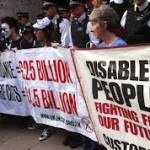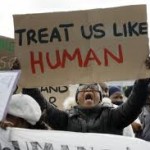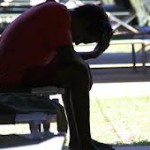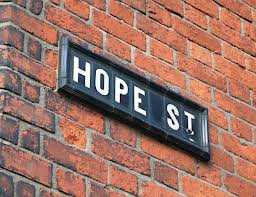Detention to sanctuary via Kew Cottages
March 31st, 2013 | Published in (Dis)ability, Asylum; Refugees, Favorites

I believe we should be providing sanctuary and inclusion for people seeking asylum in Australia, not detention and exclusion, and will hold that idea no matter how naïve it currently seems. Naivety and hope are close
companions, and without hope there is little chance of change. In this post, I sideline the rhetoric about stopping the boats to save lives, and wonder, instead, how we might respond to the people on the boats as human beings – ones who can make their own decisions, and have done so under dire circumstances.
My starting point is the example provided by the shift, for people with disabilities, from institutionalisation and exclusion to community living and participation. Some of the ideas that mobilised this transition (surely equally unlikely at the time) are also relevant to the current situation for people seeking asylum.
The precedent of deinstitutionalisation
Many of us probably remember times of feeling excluded. Not a good feeling and not one to knowingly inflict on others – if empathy prevails. My first inkling of what it might feel like to be seriously excluded was part of the landscape of my childhood. I grew up in Kew, not far from Kew Cottages, and have blurred and rather scary memories of a vast grey structure with looming towers and blank windows – like an Alfred Hitchcock movie. I knew there were children in there somewhere, and I knew they were called ‘imbeciles’, ‘idiots’, ‘morons’ and ‘spastics’. These terms were also hurled as insults at children on the outside, and there was a vague threat of ending up on the wrong side of those walls if we stepped too far over the line – not hard in the Australia of the 1950s and 60s.
Fast-forward several decades and I have recently reviewed a book by Christine Baxter on the disability movement. This is a wonderfully accessible account of the haphazard path of progress from warehousing people in Dickensian ghettoes to development of community living. Some landmark ideas include:
- Humanisation is the cornerstone. People with disabilities are people first, with much the same feelings, curiosity, and need for respect as any person. Once we allow ourselves to know that, we also become capable of empathising, and therefore recognising that exclusion from community is no more acceptable for them than for anyone else.
- Deinstitutionalisation becomes imperative. Institutions, even caring ones, cater for objects rather than subjects (that is, individuals with awareness). In one brief but profound example, Christine Baxter describes visiting an institution as a student. The children were on display, or at least parts of them were. She recalls a young boy whose epicanthic fold and large tongue were pointed out for attention. She wondered whether he had a name. That pretty much said it all for me because, of course, a person has a name, whereas an object does not. I found myself thinking of that young boy (in my mind I called him James), and wondering if he is still alive, and where he might be.
- Education takes priority. Living in the community involves skills including accessing services, using transport, working, and communicating. These skills need teaching and learning. Progress towards deinstitutionalisation therefore involved shifting the emphasis from medical models to educational ones. Terms such as ‘moron’ were originally medical descriptions, with the unfortunate side-effect of reducing people to labels – just as inadequate for people with disabilities as it would be for me as ‘a myopic’ or ‘an arthritic’. I imagine I might become quite terse if anybody referred to me in such totalising terms. The shift in emphasis, from medicalisation to education, created space for the person beyond the label, a person capable of learning and developing skills, communicating and building relationships.
- Community adjustment. The transition of people with disabilities from institutions into the community involved adjustments on the part of community: the concept of normal needs to flex; differences need to be accepted; housing, schooling, employment, health, and recreation facilities need to be accommodating; the physical environment needs to be accessible; and families and carers need support. These adjustments are ongoing.
I admire those, including Christine Baxter and colleagues, who mobilised change over several decades. There must have been times when the obstacles seemed insurmountable and the vision ever-receding. Their example gives me hope even though, as Baxter notes, the revolution is never complete.
People seeking asylum are also people first
The parallel change I hope to see is for people seeking asylum, and humanisation is again pivotal. Stories about people (who happened to arrive by boat) with needs, hopes, skills, families, and responsibilities are available in multiple forms (books, websites, film, theatre, documentaries) for those prepared to notice, and communities sometimes also tell positive stories about their experiences with refugees.
One such story I remember being written up in the media involved young Afghan men who were living in the Victorian city of Shepparton. They were initially treated with suspicion by existing residents, but gradually gained acceptance because they worked hard in the local industries, probably at jobs nobody else wanted to do, made an effort to learn English, and didn’t cause trouble. They told interesting stories about places locals were unlikely to get to visit and introduced new ideas and culture and food. They contributed to the community and were, in turn and in time, welcomed into it.
 Such stories have, unfortunately, generally been swamped by dehumanising and inaccurate ones about ‘illegals’, ‘queue jumpers’, ‘irregular maritime arrivals’, and ‘potential terrorists’. These labels are reductionist, leaving no space for personhood, just as ‘imbeciles’, ‘idiots’ and ‘spastics’ were totalising of people with disabilities. The main distinction between the two sets of labels is that one went with a medical discourse and the other with a legalistic one.
Such stories have, unfortunately, generally been swamped by dehumanising and inaccurate ones about ‘illegals’, ‘queue jumpers’, ‘irregular maritime arrivals’, and ‘potential terrorists’. These labels are reductionist, leaving no space for personhood, just as ‘imbeciles’, ‘idiots’ and ‘spastics’ were totalising of people with disabilities. The main distinction between the two sets of labels is that one went with a medical discourse and the other with a legalistic one.
Exclusion by demonisation has dominated the public domain for far too long. If, however, we could sweep away the accreted murk, I believe the objectives for people seeking asylum are similar to those of the disability movement: we need to recognise people as human beings, liberate our capacity for empathy, replace detention and exclusion with sanctuary and inclusion, and adjust accordingly.
Sending people to places like Nauru and Manus Island bellows exclusion. My  father worked in Nauru around the time of the Second World War. The hand-carved camphorwood chest he brought back from there was the most treasured possession in our household, and I had very romantic views about a country that could produce such beauty. I know a little more now about the living conditions on Nauru, particularly as applied to people seeking asylum, and the illusions of my childhood have been laid to rest.
father worked in Nauru around the time of the Second World War. The hand-carved camphorwood chest he brought back from there was the most treasured possession in our household, and I had very romantic views about a country that could produce such beauty. I know a little more now about the living conditions on Nauru, particularly as applied to people seeking asylum, and the illusions of my childhood have been laid to rest.
My father was not a refugee, but he could have been, as any of our families could have been in those post-war years. It’s not much of a leap to realise that any of the people currently on Nauru could be members of our own families. One of them could even be me!
Precedent of ‘non-status residents’ in Toronto
The ideas of sanctuary and inclusion are not as simplistic as they might first appear. Toronto, for example has recently declared itself to be a sanctuary city to its 200,000 ‘non-status residents’ (an order of magnitude greater than the numbers in Australia). These 200,000 have been given the same rights as citizens, at least while their status is assessed. They have access to services (such as health and housing) and the right to work, which means they pay taxes, and probably end up with more to spend (put back into the economy) than if they were part of the black market. They are seen, along with citizens, as contributing to the wellbeing of the city.
Toronto’s policies were implemented as a means of embracing reality, and allowing ways of monitoring it, rather than fighting against it. Similar policies have also been introduced by thirty-six American cities, including Chicago, New York City, and San Francisco.
Australia could also choose to discover pragmatic generosity.
Australian precedent
Australia’s policies have, in the past, more closely approximated sanctuary and inclusion than they do now. After the Second World War, we accepted refugees from Europe, but more particularly and more recently we accommodated large numbers of ‘boat people’ after the war in Vietnam. Malcolm Fraser, as Prime Minister in the late 1970s, took the position that we had an ethical responsibility to do what we could. We still have that responsibility, and could learn a lot from those post-Vietnam years. Obstacles existed then, as now, but were not allowed to dictate policy.
Less fear and more empathy yields people power
The main obstacle to following these precedents and developing humane policies for people seeking asylum is fear, fear, and more fear, largely irrational, tending towards collective paranoia in some pockets, and fuelled by mass media and poll-driven politics. Fear is overriding the capacity for empathy.
Alongside the need to present the human face of people seeking asylum is, therefore, the need to address and diminish fear – of the Other (anybody different), of internal displacement (jobs, housing, services being taken away from Australians), of invasion (seemingly primal for Australians), and of terrorists (the link to people seeking asylum is, of course, unfounded). None of these fears are new, with the possible exception of fear of terrorists, and even that has some parallel with past fear of communists. I remember, as a child, peering anxiously under my bed, in case ‘they’ were there.
Such fears, if experienced only by small numbers of individuals, might be approached therapeutically – through desensitisation, flooding, rational thinking, and anxiolytic drugs, for example. At the widespread social level, however, soma is not about to provide the solution, and the circumstances are not propitious for flooding techniques, although desensitisation (through stories), and cognitive challenging (through provision of accurate information) are happening to some extent, even if not systematically or with mass therapy in mind.
Reducing mass fear is important in itself, as well as to allow space for empathy and hence increase the effectiveness of the work of humanisation. If we could build momentum from these interconnected processes we may not need to wait for courageous politicians to lead the way; we might yet find that people power can create political will.

Expanding discourses and context
The chances of change might also increase if the potential contribution of people seeking asylum was highlighted, alongside their need for safety. The language around the Toronto project emphasises contribution to the economy and society more than human rights and legality. The latter remain central (people need visas) but I suspect that, in Australia, the language of rights has been coopted by inaccurate rhetoric about illegality, and anxiety about competing rights of existing citizens. A shift to emphasise social and economic discourses about enrichment and contribution, social capital and assets (in addition to human rights and legal protections) may be an important part of the journey, just as the shift to prioritise educational models was an important part of the deinstitutionalisation journey.
Additionally, it would be useful, and appropriate, to shift discussion of people smuggling from the smuggled to the smugglers, particularly the organisational level. The various groups get conflated, to the detriment of people seeking asylum. Dealing with the organisation of smuggling is a separate agenda, and should be dealt with separately. Punishing those who arrive by boat (the smuggled), in the name of deterrence, is at best an indirect and inefficient method of tackling the industry.
Punishing those who arrive by boat is also unacceptable victim-blaming, and becomes no less so for being couched in rhetoric about saving lives. Such pious fiction is implausible and dishonest; it’s not about saving lives; it’s about sovereignty, and the power to exert it. If I was one of the people desperate enough to get on one of those derelict boats, I would curl my lip at anyone crass enough to tell me they were acting in my best interests by urging me to stay where I was; that, indeed, I would be better off doing so.
The patrony of privilege can be breathtaking.
There are, of course, huge numbers of people displaced worldwide, and this reality also needs serious and separate consideration. Many millions are currently in camps and face years before settlement. This is a global crisis that won’t resolve itself, and won’t be resolved by individual countries battening their borders and retreating into denial. Malcolm Fraser recently advocated a worldwide campaign to find homes for all those in camps – led by Australia as a new member of the Security Council. That would be something to be proud of.
Australians might embrace local reality more readily if they were shown such evidence as does exist of constructive responses at the global level, and could be invited into making a valuable contribution.
Conclusion
At the end of the day, what is required (sanctuary and inclusion) is possible in principle, and has precedent in relation to other groups (people with disabilities, for example), at other times (after World War Two and the Vietnam War), and in other places (Toronto and cities in the USA).
Some of the important milestones along the way include humanisation of people seeking asylum – through stories, and creating receptiveness to stories by reducing fear. Additional milestones include building recognition of the contribution these people can make to the economy and society; shifting the focus from people who arrive by boat to the organisations that run the boats; and locating the Australian situation in a global context to which we can make a valuable contribution. Working towards these milestones paves the way for people power to do its job, and for Australian society to accommodate whatever adjustments are involved.
In concluding this post, I return to the ideas of sanctuary and inclusion as anchors, something to hang on to through the inevitable bouts of despondency, feelings of impotence, and sense of floundering. I know I’m in good company in believing change is necessary and, for now, unwavering belief in the necessity must be enough to keep working towards it. In the interim, some comfort is possible from knowing of past achievements, even if the circumstances are not directly parallel.
We can, and should, provide sanctuary and inclusion for people seeking asylum.
This could, and should, happen sooner rather than later.

Comments from the grass roots
Christine Baxter: Community placement as bridge to inclusion
(Christine Baxter is the author of ‘Inclusion:Battling forDisability’ referred to in the post. She completed her PhD, published, and worked in the area over many years. She comments here on community placement as a bridge to community inclusion.)
As someone who pushed for the closure of disability institutions, I fear that anyone detained in such a place will have their humanity diminished. In the case of children with disability, institutionalisation meant removal from their family, no access to education and no opportunity to contribute to a potentially accepting community. Their development was stunted. But as my book ‘Inclusion’ shows, change happened! Dehumanising labels disappeared when the institutions were closed down and residents became participating members of the community.
So what hope is there for refugees in institutionalised detention centres? Well, families provide a bridge to community inclusion. That’s why I’m so positive about the community placement schemes for refugees in Australia. Community groups and volunteer families provide support, and introduce refugees to their community. I’m sure this is already breaking down barriers and will speed up community acceptance and inclusion. May there be more of it!
Rui Santos: Separating refugee determination and migration
(Rui Santos is a Social Worker who has supported, advocated and campaigned for people seeking asylum over many years. Here he outlines an innovative idea for policy change.)
One change worth campaigning for would be to remove the Australian refugee determination process from the Department of Immigration and Citizenship. Instead, an independent statutory body could be established to ensure basic human rights for asylum seekers, assess protection applications, and monitor Australia’s commitments as a signatory to the Refugee Convention.
Separation of migration and refugee determination processes would subvert the current (and some would say deliberate) confusion about definitions of refugees and asylum seekers, legal/illegal distinctions, people smuggling and criminality, and ‘stopping the boats’. Policy responses along these lines have become increasingly absurd over the years since Tampa, and while some such matters may be relevant for a Minister of Immigration or a Minister of Defence, they would be outside the domain of a Minister for Human Rights.
The provisions of the Refugee Convention are that anyone who seeks to make a claim for asylum, regardless of the circumstances in which they have arrived, automatically has the right to have their claims assessed under due process and to be afforded refuge and practical assistance in the interim.
Response to these provisions might improve on the current dismal situation if a prism of human rights replaced that of migration policy. We would then be able to refocus on the vast majority of asylum seekers who require protection and pose no threat at all to national security. We could refocus on humans, and their intrinsic rights as humans, rather than limiting our vision to fine tuning migration policy.
Brigid Arthur: Community education as key to change
(Brigid Arthur co-founded the Brigidine Asylum Seeker Project, BASP, in 2001, which has housed and supported people seeking asylum in ways that have been invaluable for those supported as well as for the health of our collective psyche. Brigid and her colleagues have worked tirelessly and persistently to keep hope alive. She comments here on the importance of community education for achieving change.)
Sanctuary and inclusion are powerful concepts. They encapsulate many things we want for ourselves and dream of for all others.
I believe the way they will be achieved for those seeking a safe haven is by community education.
This should result in advocacy for good refugee policies and processes. We need to articulate and promote an alternative policy response based on human rights. This would involve a more general understanding and acceptance of the fact that many of the present polices are an abuse of human rights and not aligned with relevant conventions and laws. I think many key messages need to be explained in an in-depth and sophisticated way to assist advocacy efforts and to influence the general public.
Accessing relevant research and information and offering educational activities such as forums and public education activities means more people can make informed judgements and engage in the debate in better ways. Part of an education campaign would be better informed media and more in depth discussion of policy issues in the media.

With thanks to Christine, Rui, and Brigid for their work and their comments.
You are warmly invited to add your feedback, comments, and ideas.


